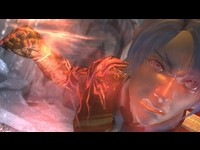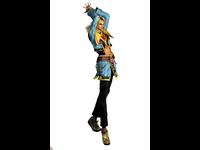|
|

|
BATTLE SYSTEM
|

|
INTERACTION
|

|
ORIGINALITY
|

|
STORY
|

|
MUSIC & SOUND
|

|
VISUALS
|

|
CHALLENGE
|
Hard / Unbalanced
|
COMPLETION TIME
|
40-50 hours
|
|
OVERALL
2.0/5
|
Rating definitions
|
|
|
Let's face it: next-gen RPG pickings are rather slim right now, so when Enchanted Arms was announced for the Xbox 360, starved RPGamers were ready to eat up just about anything. What they got, unfortunately, was a poorly localized game with an oddball creature collection system and pseudo-tactical battles. While Enchanted Arms is certainly not the worst game ever made, a number of bizarre, often-times infuriating, game play mechanics, frustrating difficulty spikes, and horrible localization problems result in a game that, while fun at its core, leaves a lot to be desired.
Enchanted Arms begins in Yokohama City, where the protagonist, Atsuma, is attending classes with his best friend, Toya (or is it Touya? Ubisoft can't seem to make up its mind), and the homosexual saxophone player who loves him. The silly character designs don't end there, however, as virtually every character in the game is a static, unchanging stereotype, with only a rare few showing any real depth. What's more, these silly stereotypes stand in stark contrast to the rather serious plot.
 Despite being called Enchanted Arms, there is only one in question. Ironically, it's not enchanted either.
Despite being called Enchanted Arms, there is only one in question. Ironically, it's not enchanted either.
|
|
That said, Makoto (the gay musician) is actually quite entertaining for the brief time he's present, but sadly, circumstances eventually lead to Atsuma and his friends parting ways. Atsuma, as it turns out, has a very special right arm, which has the unique ability to negate enchantments - a sort of magic present in the game's world - and absorb them. When a stray dog that Atsuma has been looking after leads them into a hidden chamber beneath their school, Atsuma's arm breaks the seal binding the Queen of Ice, a Devil Golem who has been locked away beneath the city since the end of the Golem Wars 1000 years earlier. While the story is a fair bit different than the average RPG fare, the terrible characters and poorly written dialogue fail to make it work. Instead of a gripping narrative, you're stuck with tripe that feels like it was written in an eighth grade English class.
In addition to your basic party members, you can also collect a wide variety of golems: robots designed to do the bidding of people. Collecting them can be as easy as buying them from a store, to tracking them down in the wild and defeating them. Unfortunately, other than their basic parameters, golems are completely uncustomizable and generally fairly limited, which means that for the most part you'll wind up relying on your party members, simply for the sake of versatility. This leaves the creature-collection aspect of Enchanted Arms more of an afterthought, and generally unexciting.
Combat is one of the few things Enchanted Arms does well, even if it is hampered by egregious difficulty spikes and frequent random encounters. Titled the "Speed Tactics" battle system, it's an unusual hybrid of traditional turn-based game play and tactical combat. The battle screen is split into two three-by-four grid halves, one for your party and one for your opponents. Each character can move around on the grid in order to get enemies into range of their attacks or escape the range of upcoming enemy assaults. A simple elemental system is also in place, but what really sets it apart is the fact that there isn't any defensive stat involved in the damage calculations. Instead, the attack's base power is used as a percentage against the character's relevant stat, and whatever the value that results is always the amount of damage you deal (unless an elemental resistance or weakness comes into play, in which case you either divide or multiply by two respectively.) While this leaves the combat feeling very mathematical and far more strategic, it also means that character level is essentially irrelevant, particularly towards the end of the game, with parameters such as health, direct damage, ranged damage, and support skill being far more important. These can be raised manually by using SP (Skill Points) earned in battle.
 What other game has a flamboyant, saxophone-playing homosexual?
What other game has a flamboyant, saxophone-playing homosexual?
|
|
There are defensive measures that the player can take, however. Aside from simply using party members from the same element as the opponent, there are also a number of skills that can reduce damage by a percentage, and by positioning characters behind one another, damage from direct attacks can be reduced, which adds another level of strategy to the battles. However, boss fights generally rely too heavily on EX attacks - a kind of super-powerful attack only available to human party members (and another reason not to use golems), and require a fair amount of battling before the boss in order to build up the meter. The meter only builds up when a character dies or you defeat an opponent, so building it up in the middle of battle is generally impossible. Many of the bosses also have absurdly powerful attacks, and failing to defeat them within a few turns generally means you won't be winning at all.
While combat is mostly enjoyable, it is further hindered by the Vitality Points system, which replaces the standard loss of health present in most games. At the end of each battle, HP and EP (magic points) are both restored to full, but the characters who participated lose Vitality Points. If these points reach zero, the character begins battles with only one HP and EP, essentially rendering them useless. These points can only be restored at special healing stations (which are generally few and far inbetween), by using a rather expensive healing item (which you can only hold nine of at a time), or by placing the character in reserve and walking around for a while (though you can only do this if the character hasn't already reached zero vitality). To top it off, the main character, Atsuma, cannot be removed from the party at any time, meaning that unless you have a good supply of those aforementioned items, there is a time limit to getting through any given area. Since some of these areas are quite large, and often involve puzzles, it's likely that you will be backtracking to healing stations a number of times throughout the game. If you were thinking that you could simply start escaping from battles if your VP was getting low, you'd be wrong. In fact, you'll likely wind up losing more VP that way than if you simply fought your way through. Enchanted Arms is the only RPG I've ever played in which escaping is generally more harmful than actually fighting the opponent.
Audio is probably the most atrocious problem in Enchanted Arms. The soundtrack is decent, if somewhat unexciting, but this isn't the offender in this case - it's the voice acting. Enchanted Arms features some of the worst voice acting in recent memory, with the few bits and pieces that are done well being reserved for minor characters and ruined by poorly written dialogue. While most all the voice acting is bad, the worst of the worst is that of the main character, Atsuma. His voice actor frequently places inflection on the wrong word in the sentence, speaks with a prominent lisp, and fails to put any emotion into scenes in which the character should, by all means, be shouting at the top of his lungs. The Japanese voice track is available, but this doesn't change the terrible translation.
Despite all its shortcomings, Enchanted Arms did manage to create a beautiful world, even if it is somewhat unoriginal in design. The graphics are clear, crisp, and spectacular to behold, and subtle effects such as moving clouds, billowing dust, and in particular the beautiful ethereal fireworks above the Queen of Ice's palace, are used well and often. The only downside would be the uncreative locales, such as London City, a very generic medieval English town, and Kyoto City, resting at the base of Mt. Fuji, which is about as traditionally Japanese as a city can get. Junk City, however, is particularly unique, built in between and around the ribs of a giant fossilized skeleton. It's very evident from a graphical standpoint that this is a next generation game.
With a few fun aspects to it, Enchanted Arms is worth taking a look at for its unusual battle system, but it falls short in all other areas. It clocks in at between forty and fifty hours and features two endings, though one of them isn't so much an ending as a sudden rolling of the credits with no story closure whatsoever. It also causes you to skip several boss fights, which may be a good thing, depending on how you look at it. The skipped boss fights are among the hardest in the game and will likely require several hours of additional training before successfully taking them on. All in all, Enchanted Arms is a very poor start to the next generation of RPGs, but hey - it's something, right? Don't be fooled. Wait. The good games are coming.
Review Archives
|









